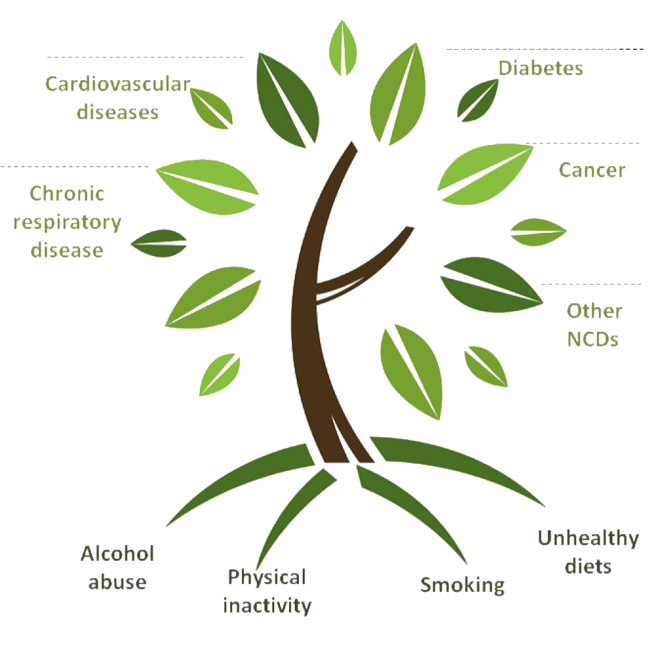What Are NCDs?
Non-Communicable Diseases

Key Facts:
Each year, more than 15 million people die from a NCD between the ages of 30 and 69 years; 85% of these “premature” deaths occur in low- and middle-income countries.
77% of all NCD deaths are in low and middle-income countries.
Cardiovascular diseases account for most NCD deaths, or 17.9 million people annually, followed by cancers (9.3 million), respiratory diseases (4.1 million), and diabetes (1.5 million).
These four groups of diseases account for over 80% of all premature NCD deaths.
Tobacco use, physical inactivity, the harmful use of alcohol and unhealthy diets all increase the risk of dying from a NCD.
Detection, screening and treatment of NCDs, as well as palliative care, are key components of the response to NCDs.
People of all age groups, regions and countries are affected by NCDs. These conditions are often associated with older age groups, but evidence shows that more than 15 million of all deaths attributed to NCDs occur between the ages of 30 and 69 years. Of these “premature” deaths, 85% are estimated to occur in low- and middle-income countries. Children, adults and the elderly are all vulnerable to the risk factors contributing to NCDs, whether from unhealthy diets, physical inactivity, exposure to tobacco smoke or the harmful use of alcohol.
These diseases are driven by forces that include rapid unplanned urbanization, globalization of unhealthy lifestyles and population ageing. Unhealthy diets and a lack of physical activity may show up in people as raised blood pressure, increased blood glucose, elevated blood lipids and obesity. These are called metabolic risk factors that can lead to cardiovascular disease, the leading NCD in terms of premature deaths.
People at risk of NCDs
Modifiable behavioural risk factors
Modifiable behaviours, such as tobacco use, physical inactivity, unhealthy diet and the harmful use of alcohol, all increase the risk of NCDs. Below are the key findings of behaviour risks in the Federation of St. Kitts and Nevis on various health behaviours, including smoking, drinking alcohol, eating fruits and vegetables and physical activity. (Risk Factor Survey 2007).
The overall proportion of those that are overweight or obese (defined as BMI ≥25kg/m2) in the study population was 78.5% and the proportion of those with obesity (BMI ≥24kg/ m2) was 45.0%. For males, 74.1% were classified as either overweight or obese with 37.9% being obese. For females, 83.0% were classified as either overweight or obese with 52.5% being classified as obese.
The percentage that currently smokes tobacco daily was 8.7% with a gender difference of 16.2% males and 1.1% of females.
The overall prevalence of current alcohol consumption in the population was 29.8% with 45.1% of males and 14.3% of females.
Overall, 97.3% of the respondents consumed fewer than 5 of the combined servings of fruit and vegetables per day.
In general 38.3% of the study population was classified to be moderately inactive, or with low levels of physical activity (28.3% of males and 48.5%) of females).
The total prevalence of high blood pressure amongst males in the survey was 33.2% while that amongst females was 19.6%.
Approximately 45.4% of the population under 45 years old have at least three of the key risk factors for a chronic disease.
Metabolic risk factors
Metabolic risk factors contribute to four key metabolic changes that increase the risk of NCDs:
Raised blood pressure;
Overweight/obesity;
Hyperglycemia (high blood glucose levels); and
Hyperlipidemia (high levels of fat in the blood).
In terms of attributable deaths, the leading metabolic risk factor globally is elevated blood pressure (to which 19% of global deaths are attributed)(1), followed by overweight and obesity and raised blood glucose.
The socioeconomic impact of NCDs
NCDs threaten progress towards the 2030 Agenda for Sustainable Development, which includes a target of reducing premature deaths from NCDs by one-third by 2030.
Poverty is closely linked with NCDs. The rapid rise in NCDs is predicted to impede poverty reduction initiatives in low-income countries, particularly by increasing household costs associated with health care. Vulnerable and socially disadvantaged people get sicker and die sooner than people of higher social positions, especially because they are at greater risk of being exposed to harmful products, such as tobacco, or unhealthy dietary practices, and have limited access to health services.
In low-resource settings, health-care costs for NCDs quickly drain household resources. The exorbitant costs of NCDs, including treatment which is often lengthy and expensive, combined with loss of income, force millions of people into poverty annually and stifle development.
Prevention and control of NCDs
An important way to control NCDs is to focus on reducing the risk factors associated with these diseases. Low-cost solutions exist for the Ministry of Health and other stakeholders to reduce the common modifiable risk factors. Monitoring progress and trends of NCDs and their risk is important for guiding policy and priorities.
To lessen the impact of NCDs on individuals and society, a comprehensive approach is needed requiring all sectors, including health, finance, transport, education, agriculture, planning and others, to collaborate to reduce the risks associated with NCDs, and to promote interventions to prevent and control them.
Investing in better management of NCDs is critical. Management of NCDs includes detecting, screening and treating these diseases, and providing access to palliative care for people in need. High impact essential NCD interventions can be delivered through a primary health care approach to strengthen early detection and timely treatment. Evidence shows such interventions are excellent economic investments because, if provided early to patients, they can reduce the need for more expensive treatment.
Cancer, Cardiovascular disease, Diabetes and their related complications pose a significant threat to the health and well-being of the people of St. Kitts and Nevis. Despite the efforts undertaken thus far the prevalence of NCDs and their risk factors still continue to rise. It is therefore important to note that the health sector plays a vital role in advocacy and collaboration with other sectors in an effort to negate this trend. It is prudent to build an environment that supports healthy living and empowers healthy choices to achieve behavioral change.
(1) GBD 2015 Risk Factors Collaborators. Global, regional, and national comparative risk assessment of 79 behavioural, environmental and occupational, and metabolic risks or clusters of risks, 1990–2015: a systematic analysis for the Global Burden of Disease Study 2015. Lancet, 2016; 388(10053):1659-1724
Source: https://www.who.int/news-room/fact-sheets/detail/noncommunicable-diseases
